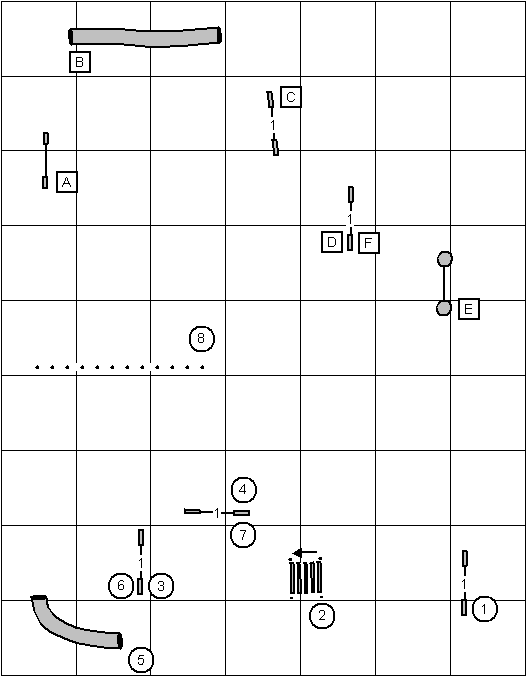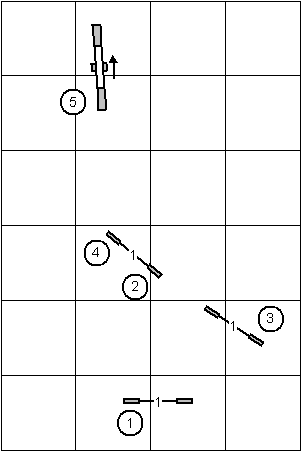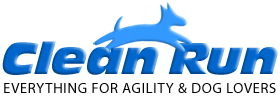By Carol Mount
How many times at a training class or trial have your heard mumblings, groans, and exclamations about something on course? They go something like this:
"Is this legal?"
"This is a nightmare."
"There's no way... this is impossible."
"How often would I see this?"
"Is this safe?"
I admit that as a student, I've been guilty of mumbling and complaining! But do you realize what the grumbling actually means? Those verbal protests mean we are being presented with a challenge that's out of our comfort zone. We are looking at a sequence and we don't know how to handle it or how the dog will respond, so our anxiety rises. Sometimes it's just the presentation of the obstacles and we don't recognize the pattern so we don't know how to approach the sequence. Other times, we just don't have the skills needed to execute the sequence.
So what do you do after you're finishing complaining? Do you buckle down and give the challenging sequence a whirl? Do you try to look for a "work around?" If you're in a class situation, do you try to learn the skill needed to do the sequence? Or, if you're at a trial, do you copy down the sequence and make notes of the skill needed so you can work on it in training? Or do you just pack it in and give it a half-hearted go, figuring that you're not likely to run into it again?
Why Move Out of Your Comfort Zone?
To explain why you might want to move out of your comfort zone, I'll share my story. I'll start by saying the well-worn punch line that "you can't teach an old dog new tricks" is balarky. It's never too late to set new goals.
I'd been in this sport for over 17 years. Although I hadn't been nationally competitive, that hadn't been a goal for me, and I'd had good success in competition by my own measurements. I knew I wasn't a poster child for agility handling, but that was okay with me. I was pretty happy in my agility world at that time. I had a full time job, survived some life events, and I was a key person in a new agility club; being part of a club is very important to me (as well as to the sport). My goals were fine goals... at least, at the time.
Eventually I decided I was missing out on some of the finer points of the sport, and I wanted to grow and be pushed. So I went out and, on purpose, I selected an exceptionally talented dog, a Malinois. I was quickly forced out of my comfort zone in both training and handling. But an interesting thing happened. As I worked to handle and train at the level needed for my young dog, I found my older, softer, slower dog was benefiting from my new skills as well. I found that some of the problems I was having with my older dog were happening because I had never taught him certain skills; I didn't care about being extremely competitive, so at the time I didn't think he needed those skills. Some handling skills were lacking because I didn't "get" the finer points of handling; other handling skills were lacking because I didn't think I needed them so I had never learned them; and still others were lacking because agility training and handling are progressing every day and those skills didn't exist when I trained him. Who could have imagined that a Chinese Crested needed to work on jumping collection for a turn? I mean, he's a small dog and we all know they have lots of strides to adjust their path. Yet now that I've worked with my larger dog, I've realized my toy dog could have learned to turn better off a jump. I could also have trained myself skills to handle him better on those turns. Oh, he gets through courses, but we throw several seconds down the drain. And those seconds are more important for him than for the fast, driven dog.
Don't assume because your dog isn't a speeding bullet and you don't care about competing at the highest level that you don't need to be challenged. Don't think that the finer points can't apply to you and your dog. Skills, course analysis, and handling for slower dogs are very important and probably more important when you're often missing a Q by a few seconds. And never assume your dog doesn't need a skill. If you make that assumption, at some point you will have to choose to handle to the dog's lack of skill, rather than to the course. You will give away seconds, and maybe a Q.
Here are some of my reasons for breaking out and pushing limits:
- You and your dog will perform better at trials if you improve your handling skills and your dog's skills. It's well documented (http://en.wikipedia.org/wiki/Comfort_Zone_Theory ) that performance declines rapidly as higher levels of anxiety or discomfort occur. If you and your dog are often faced with challenges that you cannot handle, your anxiety in competition will be very high. Increasing your and your dog's skill sets by periodically training on difficult courses and sequences, will improve performance not just because of the improved skills, but because you are decreasing anxiety.
- You will understand your dog better and how he moves and reacts on course as you improve your skills. You will learn what your dog needs to perform at his best. Can you tell when your dog is committed to an obstacle? Do you know where your dog will land off a sequence; how he will turn? How many strides will your dog take in a particular situation? For difficult sequences, do you know how to keep up the dog's motivation and speed?
- You will become better at course analysis by increasing your knowledge of an organization's rules and trends. It's easy to just run a course without thinking about why the course was designed the way it was, but if you understand what each agility organization will "test" you on and what type of challenges, spacing, and angles are allowed, you will become a better at course analysis. Good course analysis skills help give you that feeling of "owning the course," and that feeling increases your confidence and reduces anxiety.
How Can You Push Yourself?
Now that you know why it's good to get out of your comfort zone, how do you break out and push yourself? If you only run courses from the previous weekend to try to improve yourself, you will get stuck on that venue's presentation of skills. And if you rely solely on your instructor to challenge you, you can also get stuck in a rut. As an instructor, I can tell you that it's very easy for instructors to slip into setting up courses and challenges they are comfortable with. Yep, even instructors can get stuck in their own comfort zone.
Knowing this, you need to learn to push yourself sometimes. Here are some of the things I have done to try to push myself:
- Go international. I love to search the web for FCI-style agility. I have found some really cool dogs (on video websites such as YouTube) and agility courses. Not only can you see what's being set up and run on the other side of the ocean, you can discover trends and challenges they are seeing. I'm far enough along in trying to push myself that when I watch a video and say "No way," I find my scowl quickly turning into a devilish smile and then I say "cool" and pick that sequence to use as basis for training sequence.
- Find videos of dogs like your dog in different parts of the country and even overseas. Watch how they move and how they land off jumps and sequences. If you can't find your breed, look for dogs of similar size and structure.
- Find videos of handlers that move like you. For example, you maybe be watching runs from a particular event and say, "No way I could get there!" for a particular part of the course. But continue watching until you find a handler that moves like you do. If that handler in the video can get somewhere, so can you. Watch and take notes about how that handler did it so that you can practice.
- Find handlers and dogs that you admire and want to be like. What can you do to be like them?
- Find a handling discussion group.
Going International
Many sequences in international agility courses can be uncomfortable to U.S. handlers since we typically don't work on the skills needed for them. So I'll share some of the websites, videos, and handlers that have inspired me to get out of my comfort zone.
Some International Handlers
Here are a couple of well-known international handlers I follow on line because I appreciate their handling and training. Pay attention to their training videos in addition to the runs from trials. There are many other awesome handlers out there; the following is just a sampling.
- Jenny Damm: www.lotuseducation.se/changelang/2, www.lotuseducation.se/films, www.youtube.com/user/jennylotus1
- Silvia Trkman: silvia.trkman.net, www.youtube.com/user/yolle555
- Dave Munnings: davemunnings.webs.com, www.youtube.com/user/davemunnings
- Bernadette Bay: www.obayshelties.com, obayshelties.blogspot.com
International YouTube Channels
Some of my favorite international YouTube agility channels are ones where I've just searched YouTube and found awesome dogs and handlers I like to watch, even if they are still training. The ones below have dogs similar to mine. I'm watching how they are training, how the dog responds to their movement, and what the dog is capable of doing.
- www.youtube.com/user/Lloydsun
- www.youtube.com/user/Anikaa20
- www.youtube.com/user/amonraMK
- www.youtube.com/user/chanelsony
- www.youtube.com/user/GRITTLI03
International Agility Courses
Here are some websites where you can find international agility courses (some are training courses).
- www.agility-ch.ch
- www.stratwin.fi/kennelkvarkin/agility-courses.html
- pompilio.wordpress.com/index
- granting-pleasure.de/plaene.php?anfpos=0
- www.ideat.fi/agilitytuomarit/linkit/9-ratapiirroksia
- solveigtr.com/courses-tr.htm (includes links to sites, including some of the ones mentioned here)
- www.agilitysm2009.ch/franz/wettkampf/plaene.htm
- www.europeanopen.nl/Resultaten.html
- www.belgians.nl/agendajudges.htm
- www.agilityspass.de
- www.agilitymalle.no/indexe.htm
- www.agilityeye.co.uk/past-courses.htm
- www.dvg-hundesport.de/dvg/home/agility/weltmeisterschaft/parcours.html
- users.telenet.be/ivo.tielens3/genebos/Liekens.htm
- agility57-passion.sosblog.fr/Premier-blog-b1/AGILITY-PARCOURS-D-ENTRAINEMENT-2009-b1-p7.htm
- www.agility-team-heidesheim.de/index.php?sid=33 (click on number next to course to view)
International Trends from 2009
Here are several trends I noticed when looking at courses from 2009.

The first one is a sequence that has the dog going to the back side of a jump as shown in the diagram above. You can find examples of this on several websites:
- Look at obstacles #3-#4 on this course
- Look at obstacles #17-#18 on this course
- Look at obstacles #11-#12 and #16-#17 on this course
 The next one is a sequence that has the dog running past a very obvious obstacle as shown in the diagram on the left. You can find examples of this on several websites:
The next one is a sequence that has the dog running past a very obvious obstacle as shown in the diagram on the left. You can find examples of this on several websites:
- Look at obstacles #11-#12 on the A3 Prufung course
- Look at obstacles #6-#7 on this course
- Look at obstacles #6-#7 on this course
A trend I've seen mainly in training sequences involves the jump angle after a contact.
- Look at obstacles #3-#4 and #13-#14 on this course
Also note, when looking at some of the online courses from 2009:
- Number of tunnels used on course
- Use of very short tunnels
- Weave pole entries
Finding International Courses on Your Own
How successful you are in locating international dogs and handlers to watch boils down to the words you use for searching the web and online video services like YouTube. So you need to know key agility words in other languages. You also need to know what your dog's breed is in other languages. Here are a few keywords to get you started: L'agility, d'agilite, agility, circuito de agility, Parcours, Richter, rechter, Juge, Hoppe, Hyppyrata.
There are two websites that can help you find key search words, and also to translate a website once you've found one. The translations are not perfect, but they definitely help!
How to Trace a Course Map into Clean Run Course Designer
Being able to get a course map you've found into CRCD is useful for getting exact obstacle spacing and angles for practice (if spacing is critical for the skill you want to practice). Here are some video tutorials I've prepared to help you:
Conclusion
I'm leaving you with a lot of information of places to visit. Think about how you'll challenge yourself and your dog. Have fun, learn new skills, and be successful in the ring as you work to break out and expand your comfort zone.
Carol has an MS in Mathematics and works for AT&T. She is an agility judge, part-time agility instructo,r and active member of JAG. Carol and her husband, Paul, have trained and titled several breeds in sports like agility, obedience, rally, herding and flyball. They have shown Basenjis, Malinois, Chinese Cresteds, and Border Collies. Carol's current canine partners are Chinese Crested, MACH3 Louie-Louie, and Belgian Malinois, Fusion.
Additional Resources
Here are some links on the comfort zone.
- en.wikipedia.org/wiki/Comfort_Zone_Theory
- www.motivation-tools.com/elements/comfort_zone.htm
- www.lifehack.org/articles/lifehack/how-to-break-out-of-your-comfort-zone.html
- www.nationalseminarstraining.com/Articles/Category/Creativity/COMFRTZONE



